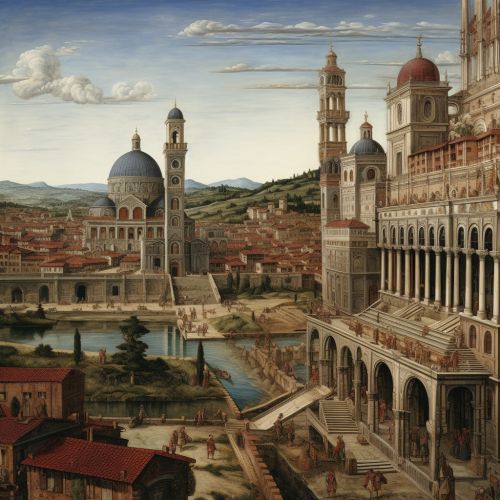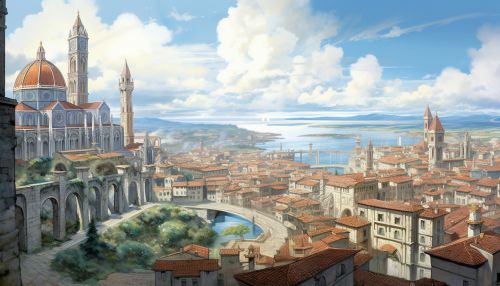Italian Renaissance
Origins and Background
The Italian Renaissance was a period of great cultural change and achievement in Europe that spanned from the 14th to the 17th century. It marked the transition from the Middle Ages to Modernity. The term "Renaissance" (Rinascimento in Italian) means "rebirth" and is used to mark the cultural revival of classical antiquityClassical Antiquity. The Italian Renaissance is often labeled as the beginning of the "Early Modern Age".
The Italian Renaissance began in TuscanyTuscany, centered in the cities of FlorenceFlorence and SienaSiena. It later had a great impact in VeniceVenice, where the remains of ancient Greek culture were brought together, providing humanist scholars with new texts. The Renaissance later had a significant effect on RomeRome, which was ornamented with some structures in the new all'antico mode, then was largely rebuilt by humanist sixteenth-century popes.


Cultural Developments and Peculiarities
The Italian Renaissance was characterized by a shift in several cultural areas, among them literature, science, art, religion, and politics. The Renaissance man, an ideal realized most notably by Leonardo da VinciLeonardo da Vinci, was an individual who possessed knowledge and skills in a number of different areas.
Literature and Poetry
In literature and poetry, the Italian Renaissance was particularly marked by a renewed interest in the classical values of Greece and Rome. This led to the development of humanist studies, which sought to create a citizenry able to speak and write with eloquence and thus able to engage the civic life of their communities. This was a return to the original precepts of the Roman Republic, which valued an active civic life and placed a premium on public speaking.
Science
In science, the Italian Renaissance saw significant advancements in a variety of areas. These included astronomy, where Nicolaus CopernicusNicolaus Copernicus proposed a heliocentric model of the solar system, and anatomy, where Andreas VesaliusAndreas Vesalius made comprehensive studies of the human body.
Art
In art, the Italian Renaissance is renowned for its significant developments in painting, sculpture, and architecture. Artists such as MichelangeloMichelangelo, RaphaelRaphael, and TitianTitian were active during this period. They developed techniques such as linear perspective, chiaroscuro (the contrast between light and dark), and sfumato (the blurring of sharp edges) that have greatly influenced Western art.
Religion
In religion, the Italian Renaissance saw the rise of movements for religious reform, most notably the Protestant ReformationProtestant Reformation, which began in the 16th century. This period also saw the Catholic Church's response to this movement, known as the Counter-ReformationCounter-Reformation.
Politics
In politics, the Italian Renaissance was characterized by the rise of city-states, such as Florence, Venice, and Rome. These city-states were often republics, although they were de facto monarchies. They were characterized by their merchant class, which was active in the governance of the cities.
Impact and Influence
The Italian Renaissance had a profound impact on Europe and the world. Its influence can be seen in a variety of areas, from the arts to science, politics, and religion. It led to a renewed interest in the classical values of Greece and Rome, which has shaped Western civilization.
